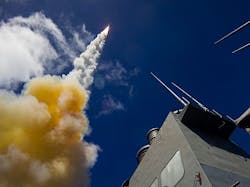Raytheon to build RIM-174 SM-6 shipboard air-defense missiles in $270.5 million contract
WASHINGTON, 29 Feb. 2016. Missile designers at Raytheon Co. will provide the U.S. Navy with shipboard air-defense missiles under terms of a quarter-billion-dollar contract modification announced Friday.
Officials of the Raytheon Missile Systems segment in Tucson, Ariz., won a $270.5 million contract option to build the Standard Missile-6 (SM-6). The shipboard missiles order brings the value of the total contract to $573.2 million, Navy officials say.
The SM-6, also called the RIM-174 Standard Extended Range Active Missile (ERAM), is deployed on Navy cruisers and destroyers to provide air defense against enemy fixed-wing aircraft, helicopters, unmanned aerial vehicles (UAVs), land-attack anti-ship cruise missiles, and ballistic missiles in their terminal phases over sea and land, Raytheon officials say.
The SM-6 uses the legacy Standard Missile airframe and engine, and adds the advanced signal processing and guidance control capabilities of the Raytheon AIM-120 Advanced Medium-Range Air-to-Air Missile (AMRAAM).
SM-6 is a key component in the U.S. Navy's Naval Integrated Fire Control-Counter Air (NIFC-CA), which helps provide Navy surface warships with over-the-horizon air-defense capabilities. It also can destroy nuclear-tipped ballistic missiles in their terminal phases.
The missile features semi-active and active homing, and launches from the MK 41 Vertical Launch System (VLS) canister aboard ship. The SM-6 is a two-stage missile with a booster stage and a second stage.
Navy crews can use the missile in inertial guided to target with terminal acquisition using active radar seeker; semi-active radar homing all the way; or an over-the-horizon shot with Cooperative Engagement Capability (CEC), which blends radar from several different ships.
The SM-6 can intercept very-high-altitude or sea-skimming anti-ship missiles. Against ballistic missiles it can discriminate targets using its dual-mode seeker, with the semi-active seeker relying on a ship-based illuminator to highlight the target, and the active seeker having the missile itself send out an electromagnetic signal.
The missile's active seeker can detect a land-based cruise missile amid ground clutter, even from behind a mountain. The Navy is adding the Global Positioning System (GPS) to the SM-6 so it can strike stationary land targets if needed. The missile also is being modified as an anti-ship weapon.
On this contract modification Raytheon will do the work in Camden, Ark.; Tucson, Ariz.; Wolverhampton, England; Andover, Mass.; Middletown, Ohio; San Jose, Calif.; Dallas; Huntsville and Anniston, Ala.; Middletown, Conn.; Clarkston, Ga.; San Diego.; Thousand Oaks, Calif.; Warrington, Pa.; and other locations, and should be finished by April 2019.
For more information contact Raytheon Missile Systems online at www.raytheon.com, or Naval Sea Systems Command at www.navsea.navy.mil.

